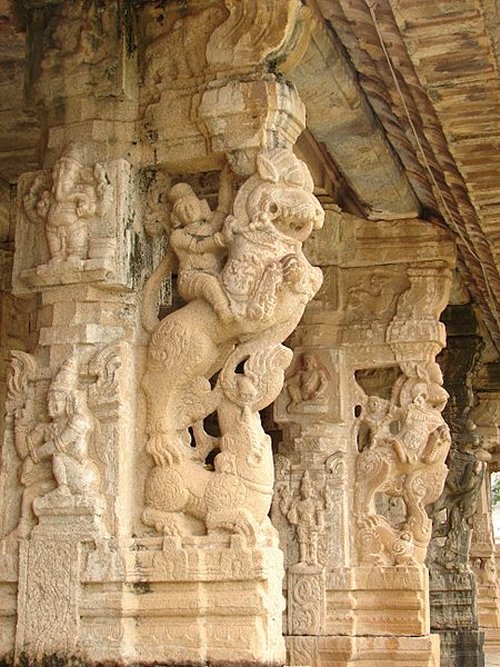Yali – Divine Protector And Guardian Of Temples Warding Off Evil Forces In Hindu Mythology
A. Sutherland - AncientPages.com - A prominent figure of Hindu mythology and a personification of natural forces that can be seen in many South Indian medieval temples is a powerful and strong Yali.
At Meenakshi Amman Temple in Madurai, the cultural capital of Tamil Nadu state, there are as many as one thousand pillars richly covered with carvings of Yali.
 Madurai Meenakshi Amman Temple. Source
Madurai Meenakshi Amman Temple. Source
The Yali - a powerful symbol of protection – can be found in the Tiger Cave, one of the Mahabalipuram rock-cut temples constructed during the reign of King Narasimhavarman I, a great warrior and a devotee of Shiva.
The king is still remembered not for the conquests but for his contributions to the art and architecture of Tamil Nadu.
Descriptions of Yali are very old, and so are references to this mythical creature, often sculpted onto the pillars in temples.
As a personification of natural forces, Yali (also known in Sanskrit as Vyala or Vidala) became prominent particularly in South Indian sculpture in the 16th century.
He was considered to be more powerful than the lion, the tiger, or the elephant. The creature was believed to have organs of horse, lion, and elephant, all together in one.
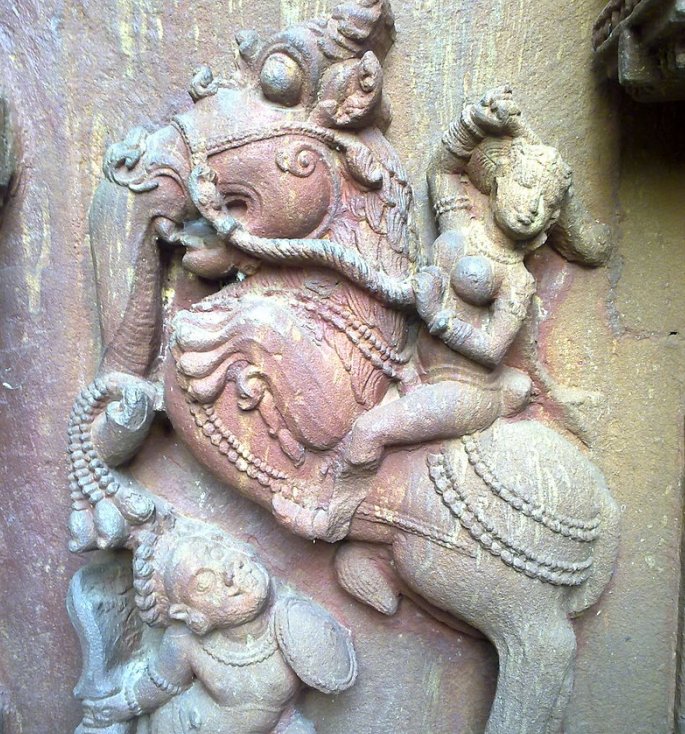
Yali and rider, Mukteshvara Temple, Bhubaneshwar, Odisha state, India. Source
Therefore countless depictions show Yali as part lion, part elephant, and part horse, but also in other similar shapes with a tail of a serpent.
Yali Is Associated With Architecture And Spatial Geometry
According to Vastu Shastra ("science of architecture"), a traditional Indian system of architecture originating in India, there are 16 types of Yalis or Vyalas.
All of them are among the finest sculptures in India, but that’s not all. The mythical Yali’s function is to define space. This function is very important in Vastu Shastra.
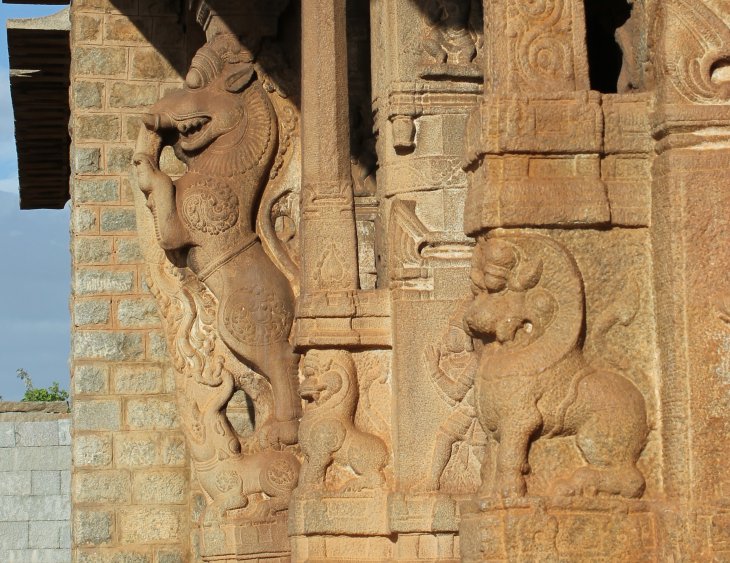
Yali pillars at Ananthasayana temple, Ananthasayanagudi, Karnataka state, India. Source
We are aware of how remarkable is the architecture of India could only be achieved thanks to principles of design, layout, measurements, ground preparation, space arrangement, and spatial geometry. All these principles are mentioned in ancient texts from the Indian subcontinent, where Vastu Shastra is closely associated with traditional Hindu beliefs and in some cases also Buddhist ones.
Yali Linked To A Griffin And A Leogryph
Yali has been sometimes described as a leogryph, commonly depicted in Burmese iconography and Myanmar architecture, especially as a pair of guardians flanking the entrances of Buddhist pagodas and monasteries. Another legendary monster with the head and wings of an eagle and the body of a lion was the griffin.
Yali pillars at the Someshvara temple in India. Credit: Dineshkannambadi - CC BY-SA 3.0
The griffin has been often compared to several ancient mythological creatures, and these include the Lamassu, an Assyrian protective deity, usually depicted with a bull or lion's body, eagle's wings, and human's head.
Lamassu guarded and supported important doorways and entrances in Assyrian palaces, while the powerful Yali sometimes depicted standing on the back of Makara, was a divine protector of temples.
The various carved statues of Yali symbolize protection, intelligence, power, knowledge, speed, wisdom, loyalty, unifying force, predator's nature, mortality, the courage of the warrior, and much more. Most of these characteristics symbolize man's struggle over the elemental and dangerous forces of nature and are clearly expressed by various carvings of the Yali. They have their honorable places in many temples of India.
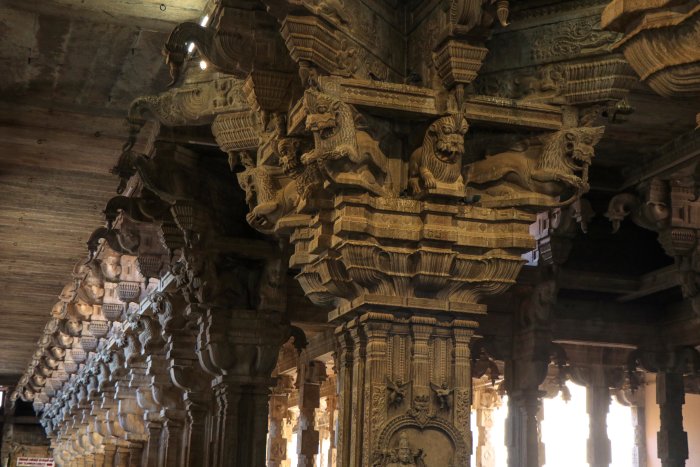
The Yali creature can be found in many Hindu temples. Credit: V.R.Murralinath - Adobe Stock
The old sculptures of the Yali are positioned on both sides of an entranceway to temples. However, in modern times, the carvings of this mysterious creature can be also found as decorations on the entrances of both residential and commercial complexes in the towns of India.
Is it just symbolically or do we perhaps still need to feel protected in some way?
Some believe that the Yali is nothing more than a fantastic legendary hybrid creature in the large pantheon of Hindu gods, goddesses, and animal-like divinities. There is currently no physical evidence to suggest that the Yali is, or ever was a real animal.
Written by – A. Sutherland - AncientPages.com Senior Staff Writer
Copyright © AncientPages.com All rights reserved. This material may not be published, broadcast, rewritten or redistributed in whole or part without the express written permission of AncientPages.com
Expand for referencesMore From Ancient Pages
-
 Ancient City Of Urkesh – Home Of Kumarbi – The Foremost Son Of Anu
Featured Stories | Aug 24, 2020
Ancient City Of Urkesh – Home Of Kumarbi – The Foremost Son Of Anu
Featured Stories | Aug 24, 2020 -
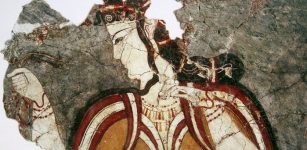 Genetic Mystery Solved: Ancient DNA Reveals Greeks Descended From The Minoans And The Mycenaeans
Archaeology | Aug 4, 2017
Genetic Mystery Solved: Ancient DNA Reveals Greeks Descended From The Minoans And The Mycenaeans
Archaeology | Aug 4, 2017 -
 Ancient Footprints Offer Evidence Humans Wore Shoes 150,000 Years Ago – Scientists Say
Archaeology | Sep 11, 2023
Ancient Footprints Offer Evidence Humans Wore Shoes 150,000 Years Ago – Scientists Say
Archaeology | Sep 11, 2023 -
 Will-o’-the-wisp: Eerie Lights Over Swamps And Marshes That Frightened And Led People Astray
Featured Stories | Apr 23, 2020
Will-o’-the-wisp: Eerie Lights Over Swamps And Marshes That Frightened And Led People Astray
Featured Stories | Apr 23, 2020 -
 King Solomon’s Copper Mines In The Timna Valley Did Not Pollute Environment – Geochemical Surveys Reveal
Archaeology | Dec 23, 2024
King Solomon’s Copper Mines In The Timna Valley Did Not Pollute Environment – Geochemical Surveys Reveal
Archaeology | Dec 23, 2024 -
 Ancient DNA Reveals A Diverse Community Lived At Machu Picchu, The ‘Lost City Of The Incas’
Archaeology | Jul 26, 2023
Ancient DNA Reveals A Diverse Community Lived At Machu Picchu, The ‘Lost City Of The Incas’
Archaeology | Jul 26, 2023 -
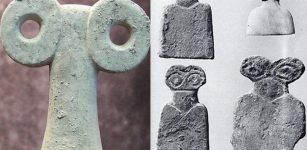 Remarkable Ancient Statues From The Eye Temple – Unique Legacy From Tell Brak, Syria
Artifacts | Jul 20, 2018
Remarkable Ancient Statues From The Eye Temple – Unique Legacy From Tell Brak, Syria
Artifacts | Jul 20, 2018 -
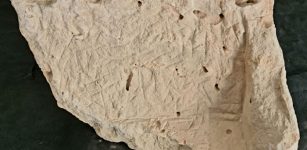 3,500-Year-Old Stone Inscribed With A Curse Against The City’s Governor Discovered In Jerusalem
Archaeology | Jul 13, 2022
3,500-Year-Old Stone Inscribed With A Curse Against The City’s Governor Discovered In Jerusalem
Archaeology | Jul 13, 2022 -
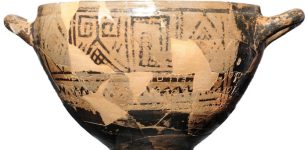 Mystery Of The Tomb Of Nestor’s Cup Unraveled
Archaeology | Oct 6, 2021
Mystery Of The Tomb Of Nestor’s Cup Unraveled
Archaeology | Oct 6, 2021 -
 Viking Grave Discovered In The Middle Of Oslo, Norway
Archaeology | Dec 23, 2022
Viking Grave Discovered In The Middle Of Oslo, Norway
Archaeology | Dec 23, 2022 -
 18,000-Year-Old Seashell Was Musical Wind Instrument Used By Magdalenian People
Artifacts | Feb 11, 2021
18,000-Year-Old Seashell Was Musical Wind Instrument Used By Magdalenian People
Artifacts | Feb 11, 2021 -
 Fra Mauro Medieval Map: Accurate And Detailed Work Attesting To Advanced Geographic Knowledge Of Contemporary Cartographers
Artifacts | Feb 8, 2019
Fra Mauro Medieval Map: Accurate And Detailed Work Attesting To Advanced Geographic Knowledge Of Contemporary Cartographers
Artifacts | Feb 8, 2019 -
 Why Didn’t Pythagoras And His Followers Eat Beans?
Ancient History Facts | Jan 18, 2019
Why Didn’t Pythagoras And His Followers Eat Beans?
Ancient History Facts | Jan 18, 2019 -
 Mysterious Time Slips Near An Ancient Church – Reported
Featured Stories | Oct 23, 2018
Mysterious Time Slips Near An Ancient Church – Reported
Featured Stories | Oct 23, 2018 -
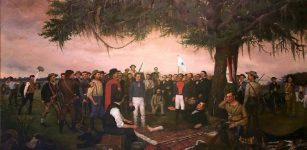 Texas Revolution – A Courageous Fight For Independence
Featured Stories | May 30, 2019
Texas Revolution – A Courageous Fight For Independence
Featured Stories | May 30, 2019 -
 Radiocarbon Dating Sheds Light On Historical Events In The Ancient City Of Gezer
Archaeology | Nov 15, 2023
Radiocarbon Dating Sheds Light On Historical Events In The Ancient City Of Gezer
Archaeology | Nov 15, 2023 -
 2,500-Year-Old Scythian Warrior Found In Untouched Grave In Siberian ‘Valley Of The Kings’
Archaeology | Jan 7, 2020
2,500-Year-Old Scythian Warrior Found In Untouched Grave In Siberian ‘Valley Of The Kings’
Archaeology | Jan 7, 2020 -
 Mysterious Giant Rock Face Discovered On B.C’s Central Coast – Natural Or Man-Made Structure?
News | Mar 28, 2020
Mysterious Giant Rock Face Discovered On B.C’s Central Coast – Natural Or Man-Made Structure?
News | Mar 28, 2020 -
 1,000-Year-Old Church Walls Unearthed In Ethiopia By Polish Archaeologists
Archaeology | Apr 26, 2020
1,000-Year-Old Church Walls Unearthed In Ethiopia By Polish Archaeologists
Archaeology | Apr 26, 2020 -
 What Does The Mexican Codex Map Represent?
Ancient History Facts | May 21, 2018
What Does The Mexican Codex Map Represent?
Ancient History Facts | May 21, 2018

